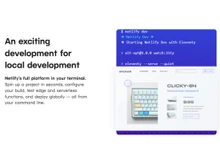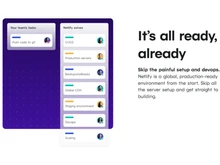Vercel vs Netlify: Which Frontend Deployment Platform Should You Choose?
For modern frontend developers, especially those building with frameworks like React, Next.js, or Vue, deployment is no longer just about uploading files to a server. Tools like Vercel and Netlify have revolutionized the Jamstack ecosystem.
These website development platforms enable continuous deployment, serverless functions, and edge performance with ease. But while both are popular choices for deploying frontend projects, they differ in workflows, pricing models, and customization options.
Whether you're a beginner deploying your first static site or an experienced developer looking for more flexibility, this guide breaks down their differences to help you choose the right platform.
Key Differences Between Vercel and Netlify
- Framework Focus: Vercel is optimized for Next.js projects and integrates deeply with it. Netlify supports all major frameworks but doesn’t specialize in any particular one.
- Pricing and Free Tier: Netlify offers more generous function and build limits on its free plan. Vercel is great for small apps but can become limiting for teams or heavier usage.
- Performance Customization: Vercel comes with automatic image optimization and edge middleware. Netlify provides flexible routing and build processes but may require plugins for full performance tuning.
- Serverless Functions: Netlify offers easier local testing and supports Deno and background functions. Vercel integrates closely with frontend code but has stricter runtime limits.
- CI/CD Experience: Vercel’s setup is streamlined for Next.js. Netlify allows greater build customization and better monorepo support.
Comparison Table: Vercel vs Netlify
| Comparison of Vercel and Netlify |
| Feature | Vercel | Netlify |
| Ideal For | Next.js, React, frontend-first apps | Static sites, JAMstack, all frameworks |
| Framework Support | Optimized for Next.js | Framework-agnostic (React, Vue, Svelte) |
| Build & Deploy | Git-based, automatic deploys | Git-based, flexible build settings |
| Edge Functions | Yes (middleware) | Yes |
| Serverless Functions | Yes (Edge/Serverless) | Yes (Node.js, Deno, background) |
| UI/UX | Clean, fast, minimal setup | Structured, beginner-friendly |
| Custom Domains | Free with SSL | Free with SSL |
| Free Plan Limits | 100GB bandwidth, 1GB storage, 1K function calls | 125GB bandwidth, 300 build mins, 125K function calls |
| Team Features | $20/user/month | Flat $19/month |
| Analytics | Built-in (paid add-on) | Built-in (paid add-on) |
| Image Optimization | Automatic (Next.js) | Via plugins/manual setup |
| Preview Deployments | Yes (automatic from branches) | Yes |
| CDN & Caching | Global CDN, built-in caching | Global CDN, built-in caching |
| Pricing | From $20/month | From $19/month |
SWOT Analysis: Vercel vs Netlify
| SWOT Analysis |
| Aspect | Vercel | Netlify |
| Strengths | Next.js support, edge middleware, simple setup | Generous free tier, framework support, build control |
| Weaknesses | Limited flexibility, costly for teams | Requires plugins/config for advanced features |
| Opportunities | Edge compute, headless CMS stacks | Workflow automation, serverless at scale |
| Threats | Vendor lock-in with Next.js | Less optimized for dynamic frameworks |
When to Choose Vercel or Netlify?
| Use Cases and Recommended Platform |
| Use Case | Best Platform |
| Next.js or React App Deployment | Vercel |
| Static Site or Portfolio | Netlify |
| High-Volume Function Execution | Netlify |
| Team Collaboration and Flexibility | Netlify |
| Edge Middleware and ISR | Vercel |
| Custom Build Process or Plugins | Netlify |
Final Verdict: Which Is Better, Vercel or Netlify?
Both Vercel and Netlify are powerful deployment platforms that cater to modern frontend developers. Your best choice depends on your framework, project complexity, and team structure.
Choose Vercel if you're focused on Next.js or React, need seamless integration and edge-first deployment, and prefer a simple, fast developer experience.
Choose Netlify if you want framework flexibility, better serverless function scaling, plugin-based build customization, or are deploying multiple static projects.
Tip: Try deploying the same frontend project on both Vercel and Netlify to get a hands-on feel of which fits your development style. For deeper insights, reach out to our technical advisors.


 2 Ratings & 2 Reviews
2 Ratings & 2 Reviews






















